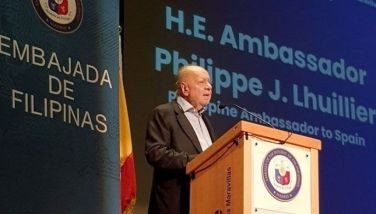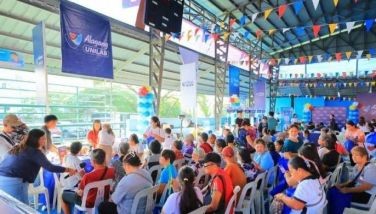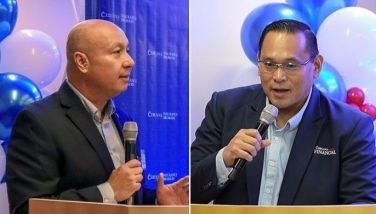Roads for progress

November 24, 2005 | 12:00am
They’re two innocent-looking "small infrastructure" projects in Tarawakan, a Muslim farming community in Bongao, Tawi-Tawi – two cemented and paved farm-to-market roads, one a one-lane 700-meter road, the other, a one-lane 600-meter road. Small they may seem, but they are actually doing wonders in improving agricultural productivity, facilitating faster commodity movement, and promoting collective community participation.
These are two of the nationwide Agrarian Reform and Asian Development Bank (DAR-ADB) Agrarian Reform Community Projects (ARCP), which will definitely promote positive ripple effects in developing many forms of livelihood in the countryside.
The DAR-ADB national project manager, Vince Camba, had invited this columnist, along with the director general of the Center for the Promotion of Peace and Development in Mindanao, Saeed A Daof, to view the two roads. The ARCP management/technical team of finance manager Carlos Rivera and consultant Gil Tuparan, who flew all the way from Manila to Bongao to accompany us to the site, said that the infrastructure projects in Tarawakan include potable water systems.
The roads and water systems are being built in many parts of the country, i.e., in 10 provinces in Mindanao, four provinces in the Autonomous Region in Muslim Mindanao (ARMM), including in Tawi-Tawi, 11 provinces in Luzon, and eight in the Visayas. All these projects are financed and constructed out of the proceeds of US$170-million (P7.2 billion) loan of the Philippine government from the Asian Development Bank.
As I said, the project in Tarawakan is small in comparison with the mega projects that we see on television, and read about every now and then in the papers. Nevertheless, they are the kind of projects that the country needs, and should be replicated in other places because they play vital roles in the implementation of the Comprehensive Agrarian Reform Program (CARP), which was initiated almost half a century ago.
This columnist interviewed some farmers, mostly originally coming from Sulu, a neighboring island province and belonging to the Tausug tribe. One said that before the roads were built, his family could only bring a small amount of products to the market, several kilometers away. They had to walk along narrow, slippery trails, with sacks of cassava or vegetables on their backs. "But with the two roads connecting our farms with the municipal roads, we could walk faster, and when there are available motorized transportation, we are able to take more products to the market on time, and in larger quantities."
Another farmer said, "I’m planning to increase the land area that I am tilling because I have more chances now of transporting more products to the market. Before, I only produced enough for our food. If I produced more, they would only rot as I could not sell them."
Another farmer, who sat down with us in a makeshift hut beside a mosque, said that he would like to plant lettuce and other vegetables, "because I know they will still be fresh when they reach the market."
I don’t have the figures to show how much time the farmers save, and the profit they make from having the roads leading to the market. But they were all smiles when I asked how much they benefited from the roads. One said, "It will be easier for our relatives to come visit us during our fiesta."
Hambre Muhammad, DAR provincial officer, said, "What’s good about the implementation scheme of the DAR-ADB project is that the Local Government Units and the communities are learning to take care of maintaining the roads. Before, after a road was constructed, these were left to the elements to deteriorate. But now the officials and the community residents have been made aware that they should take care of the roads because these link them to the market, the schools, and mosques."
This observation was corroborated by Bongao Mayor Albert T. Que, who said, "Yes, we have to take care of and maintain the roads well because we are paying a part of it in the amount of 20 percent of the cost of the road, and if we do not do this, the municipality will not be able to avail of further assistance."
One observation that this columnist believes is significant is the construction of new small houses near the roads, which serve as outlets of "imported" products from the town. One can see that even bottles of gasoline for use by tricycle operators are being sold in addition to the food items they carry. Native cassava cakes, instead of just boiled ones, are sold as well.
This means that entrepreneurship, product diversification and trading are taking off in the former "sleepy" community that depended mostly on coconut harvests, some root crops and staple products, and of course fish by the sea. This changing landscape is a good sign that the DAR-ADB infrastructure projects are becoming catalysts to trade and commerce development.
Interestingly, we found out that our companion, Saeed A. Daof, was part of a team that helped research and craft the basis of the Land Reform Code of the Philippines during the administration of the late President Diosdado Macapagal in the ’60s, and its implementation by the late President Ferdinand Marcos.
This team of young and seasoned professionals assembled at the Program Implementation Agency (PIA), and the Presidential Economic Staff (now called Presidential Management Staff), "read the minds of our late presidents in interpreting and implementing their visions in achieving massive and positive socio-economic transformation of the Philippine society into a place where disadvantaged people – particularly those three-fourths of the population living in the rural areas whose lives are tied to agriculture – can improve their quality of life, propel and deliver the nation into food self-sufficiency and surplus."
The team strongly expressed caution and reservations about the danger of indiscriminate land fragmentation that could destroy agricultural economics of scale, which could, in the future, adversely affect agri-business/agro-industrial integration, international competitiveness, and inflow of corporate-minded foreign investors.
Saeed said, the initiative should be implemented in tandem and in harmony by all government implementing agencies in providing the necessary infrastructure for agricultural development, such as roads, water, electricity, and communication systems, as well as providing access to production gradients and post-harvest facilities and equipment, marketing tools and techniques.
Saeed also observed that while millions of hectares of land have been declared land reform areas, and perhaps equivalent areas of land have been transferred to beneficiaries, the Philippines still imports basic agricultural commodities, like rice and corn, chicken wings, and vegetables from other countries.
These are two of the nationwide Agrarian Reform and Asian Development Bank (DAR-ADB) Agrarian Reform Community Projects (ARCP), which will definitely promote positive ripple effects in developing many forms of livelihood in the countryside.
The DAR-ADB national project manager, Vince Camba, had invited this columnist, along with the director general of the Center for the Promotion of Peace and Development in Mindanao, Saeed A Daof, to view the two roads. The ARCP management/technical team of finance manager Carlos Rivera and consultant Gil Tuparan, who flew all the way from Manila to Bongao to accompany us to the site, said that the infrastructure projects in Tarawakan include potable water systems.
The roads and water systems are being built in many parts of the country, i.e., in 10 provinces in Mindanao, four provinces in the Autonomous Region in Muslim Mindanao (ARMM), including in Tawi-Tawi, 11 provinces in Luzon, and eight in the Visayas. All these projects are financed and constructed out of the proceeds of US$170-million (P7.2 billion) loan of the Philippine government from the Asian Development Bank.
As I said, the project in Tarawakan is small in comparison with the mega projects that we see on television, and read about every now and then in the papers. Nevertheless, they are the kind of projects that the country needs, and should be replicated in other places because they play vital roles in the implementation of the Comprehensive Agrarian Reform Program (CARP), which was initiated almost half a century ago.
This columnist interviewed some farmers, mostly originally coming from Sulu, a neighboring island province and belonging to the Tausug tribe. One said that before the roads were built, his family could only bring a small amount of products to the market, several kilometers away. They had to walk along narrow, slippery trails, with sacks of cassava or vegetables on their backs. "But with the two roads connecting our farms with the municipal roads, we could walk faster, and when there are available motorized transportation, we are able to take more products to the market on time, and in larger quantities."
Another farmer said, "I’m planning to increase the land area that I am tilling because I have more chances now of transporting more products to the market. Before, I only produced enough for our food. If I produced more, they would only rot as I could not sell them."
Another farmer, who sat down with us in a makeshift hut beside a mosque, said that he would like to plant lettuce and other vegetables, "because I know they will still be fresh when they reach the market."
I don’t have the figures to show how much time the farmers save, and the profit they make from having the roads leading to the market. But they were all smiles when I asked how much they benefited from the roads. One said, "It will be easier for our relatives to come visit us during our fiesta."
Hambre Muhammad, DAR provincial officer, said, "What’s good about the implementation scheme of the DAR-ADB project is that the Local Government Units and the communities are learning to take care of maintaining the roads. Before, after a road was constructed, these were left to the elements to deteriorate. But now the officials and the community residents have been made aware that they should take care of the roads because these link them to the market, the schools, and mosques."
This observation was corroborated by Bongao Mayor Albert T. Que, who said, "Yes, we have to take care of and maintain the roads well because we are paying a part of it in the amount of 20 percent of the cost of the road, and if we do not do this, the municipality will not be able to avail of further assistance."
One observation that this columnist believes is significant is the construction of new small houses near the roads, which serve as outlets of "imported" products from the town. One can see that even bottles of gasoline for use by tricycle operators are being sold in addition to the food items they carry. Native cassava cakes, instead of just boiled ones, are sold as well.
This means that entrepreneurship, product diversification and trading are taking off in the former "sleepy" community that depended mostly on coconut harvests, some root crops and staple products, and of course fish by the sea. This changing landscape is a good sign that the DAR-ADB infrastructure projects are becoming catalysts to trade and commerce development.
Interestingly, we found out that our companion, Saeed A. Daof, was part of a team that helped research and craft the basis of the Land Reform Code of the Philippines during the administration of the late President Diosdado Macapagal in the ’60s, and its implementation by the late President Ferdinand Marcos.
This team of young and seasoned professionals assembled at the Program Implementation Agency (PIA), and the Presidential Economic Staff (now called Presidential Management Staff), "read the minds of our late presidents in interpreting and implementing their visions in achieving massive and positive socio-economic transformation of the Philippine society into a place where disadvantaged people – particularly those three-fourths of the population living in the rural areas whose lives are tied to agriculture – can improve their quality of life, propel and deliver the nation into food self-sufficiency and surplus."
The team strongly expressed caution and reservations about the danger of indiscriminate land fragmentation that could destroy agricultural economics of scale, which could, in the future, adversely affect agri-business/agro-industrial integration, international competitiveness, and inflow of corporate-minded foreign investors.
Saeed said, the initiative should be implemented in tandem and in harmony by all government implementing agencies in providing the necessary infrastructure for agricultural development, such as roads, water, electricity, and communication systems, as well as providing access to production gradients and post-harvest facilities and equipment, marketing tools and techniques.
Saeed also observed that while millions of hectares of land have been declared land reform areas, and perhaps equivalent areas of land have been transferred to beneficiaries, the Philippines still imports basic agricultural commodities, like rice and corn, chicken wings, and vegetables from other countries.
BrandSpace Articles
<
>
- Latest
- Trending
Trending
Latest
Trending
Recommended
























